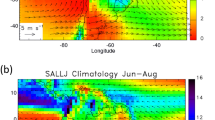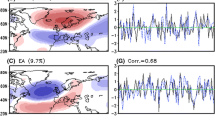Abstract
Analyzed is the interannual variability of the meridional mass transport ψS in the North Atlantic based on the Sverdrup relation. The continuous (1980–2005) monthly wind stress dataset with the spatial resolution of 1 × 1° was used as the initial data. Sverdrup transport analysis performed for different latitudinal transects within the North Atlantic subtropical gyre demonstrated that the maximum long-term Sverdrup transport (−25.2 Sv) can be found at 33°N. Studied is a mechanism of the interaction between the meridional Sverdrup transport and the water flow in the Florida Strait. The significant correlation coefficient (0.5) is revealed for the Florida Strait water discharge and the mass transport at 27°N. Analyzed is the relationship between ψS and the North Atlantic Oscillation index and the statistically significant correlation coefficient (0.45) is obtained for the Sverdrup transport at 49°N.
Similar content being viewed by others
References
N. I. Alekseevskii and S. A. Dobrolyubov, Geography, Society, and Environment: Dynamics and Interaction between the Atmosphere and Hydrosphere (Gorodets, Moscow, 2004) [in Russian].
S. S. Lappo, “On the Problem of Reasons for the Warm Advection to the North through the Equator in the Atlantic Ocean,” in The Study of Ocean-Atmosphere Interaction Processes (Gidrometeoizdat, Moscow, 1984) [in Russian].
S. S. Lappo, S. K. Gulev, S. A. Dobrolyubov, et al., “The North Atlantic and Its Impact on the Climate in Europe,” in Urgent Problems of Oceanology (Nauka, Moscow, 2003) [in Russian].
A. B. Polonskii and S. B. Krasheninnikova, “Spatiotemporal Variability of Meridional Heat Transport in the North Atlantic,” Morskoi Gidrofiz. Zh. (Mar. Hydrophys. J.), No. 6 (2010) [in Russian].
C. P. Atkinson, H. L. Bryden, J. J.-M. Hirschi, and T. Kanzow, “On the Variability of Florida Straits and Wind Driven Transports at 26°N in the Atlantic Ocean,” Ocean Sci. Discussions, No. 2, 7 (2010).
C. W. Boning and H. J. Isemer, “Monthly Mean Wind Stress and Sverdrup Transports in the North Atlantic: A Comparison of the Hellerman-Rosenstein and Isemer-Hasse Climatologies,” J. Phys. Oceanogr., 21 (1991).
A. F. Bunker, “Computations of Surface Energy Flux and Annual Air-Sea Interaction Cycles of the North Atlantic Ocean,” Mon. Wea. Rev., 104 (1976).
R. G. Curry and M. McCartney, “Ocean Gyre Circulation Changes Associated with the North Atlantic Oscillation,” J. Phys. Oceanogr., 31 (2001).
A. da Silva, A. C. Young, and S. Levitus, Atlas of Surface Marine Data. Algorithms and Procedures, Vol. 1 (NOAA, NESDIS, 1994).
P. N. Dinezio and L. J. Gramer, “Observed Interannual Variability of the Florida Current: Wind Forcing and the North Atlantic Oscillation,” J. Phys. Oceanogr., No. 3, 39 (2009).
M. H. England, M. Tomczak, and J. S. Godfrey, “Water-Mass Formation and Sverdrup Dynamics, a Comparison Between Climatology and a Coupled Ocean-Atmosphere Model,” J. Mar. Sys., 3 (1992).
D. M. Fratantoni, W. E. Johns, T. L. Townsend, and H. E. Hurlburt, “Low-latitude Circulation and Mass Transport Pathways in a Model of the Tropical Atlantic Ocean,” J. Phys. Oceanogr., 30 (2000).
S. J. Godfrey, “A Sverdrup Model of the Depth-Integrated Flow for the World Ocean Allowing for Island Circulations,” Astrophys. Fluid Dyn., 45 (1989).
S. J. Godfrey and M. Tomczak, Regional Oceanography: An Introduction (Pergamon Press, New York, 1994).
S. Hakkinen and P. B. Rhines, “Decline of Subpolar North Atlantic Circulation during the 1990s,” Science, 304 (2004).
D. E. Harrison, “On Climatological Monthly Mean Wind Stress and Wind Stress Curl Fields over the World Ocean,” J. Climate, 2 (1989).
S. Hellermann and M. Rosenstein, “Normal Monthly Wind Stress over the World Ocean with Error Estimates,” J. Phys. Oceanogr., 13 (1983).
S. A. Josey, E. A. Kent, and P. K. Taylor, “Wind Stress Forcing of the Ocean in the SOC Climatology: Comparisons with the NCEP-NCAR, ECMWF, UWM/COADS, and Hellermann-Rosenstein Datasets,” J. Phys. Oceanogr., 32 (2002).
D. A. Mayer and R. H. Weisberg, “Description of COADS Surface Meteorological Fields and the Implied Sverdrup Transports for the Atlantic Ocean from 30° S to 60° N,” J. Phys. Oceanogr., 23 (1993).
C. M. Risien and D. B. Chelton, “A Global Climatology of Surface Wind and Wind Stress Fields from Eight Years of QuikSCAT Scatterometer Data,” J. Phys. Oceanogr., 38 (2008).
W. J. Schmitz and P. L. Richardson, “On the Sources of the Florida Current,” Deep Sea Res., 38 (1991).
G. Siedler, J. Gould, and J. Church, “Ocean Circulation and Climate. Observing and Modelling the Global Ocean,” in Int. Geophysics Series (Academic Press, UK, 2001), Vol. 77.
T. L. Townsend, H. E. Hurlburt, and P. J. Hogan, “Modeled Sverdrup Flow in the North Atlantic from 11 Different Wind Stress Climatologies,” Dyn. Atmos. Oceans, 32 (2000).
Author information
Authors and Affiliations
Additional information
Original Russian Text © E.I. Klimchuk, 2013, published in Meteorologiya i Gidrologiya, 2013, No. 2, pp. 65–74.
About this article
Cite this article
Klimchuk, E.I. Spatiotemporal variability of meridional mass transport in the North Atlantic. Russ. Meteorol. Hydrol. 38, 106–112 (2013). https://doi.org/10.3103/S1068373913020076
Received:
Published:
Issue Date:
DOI: https://doi.org/10.3103/S1068373913020076




